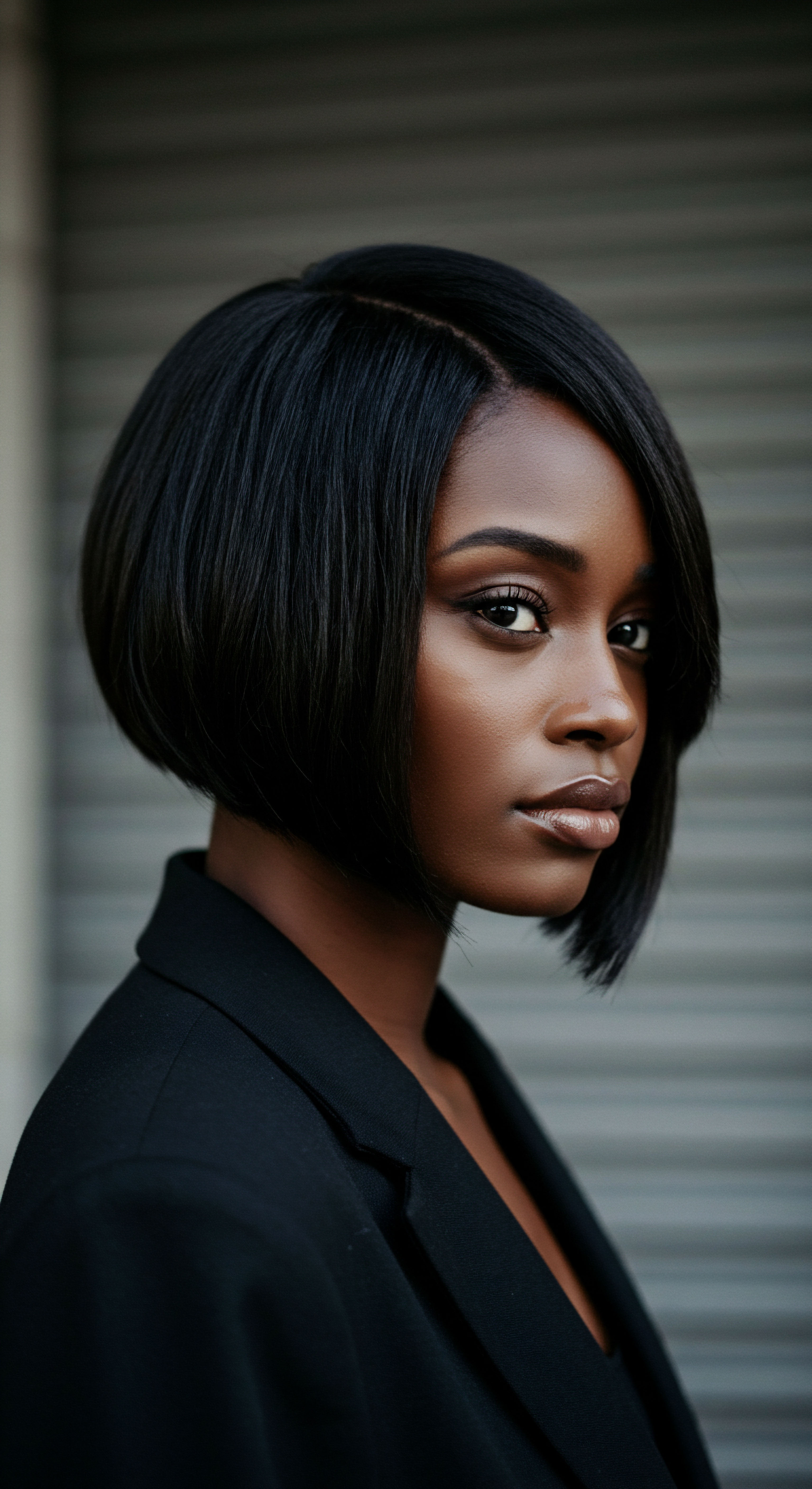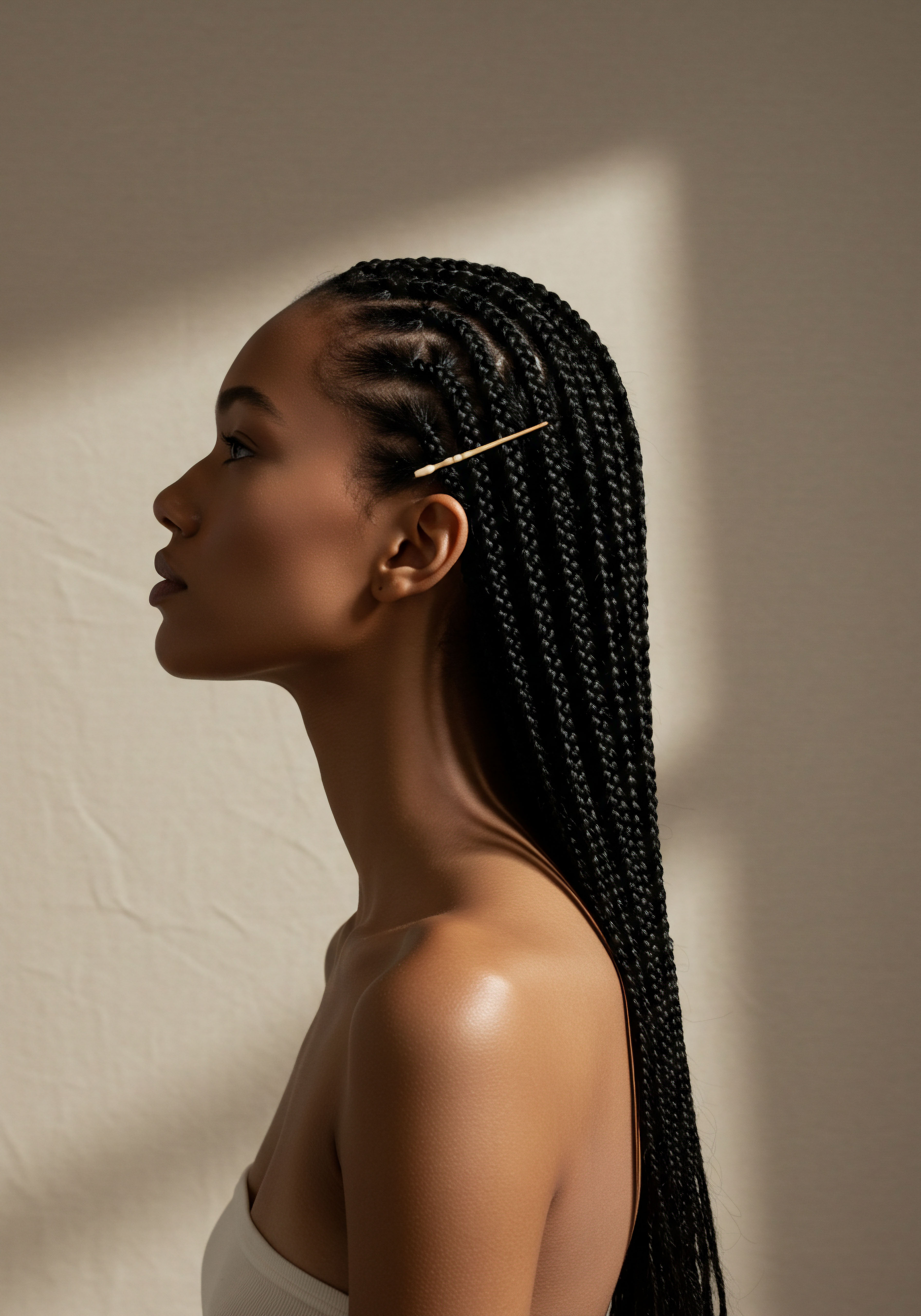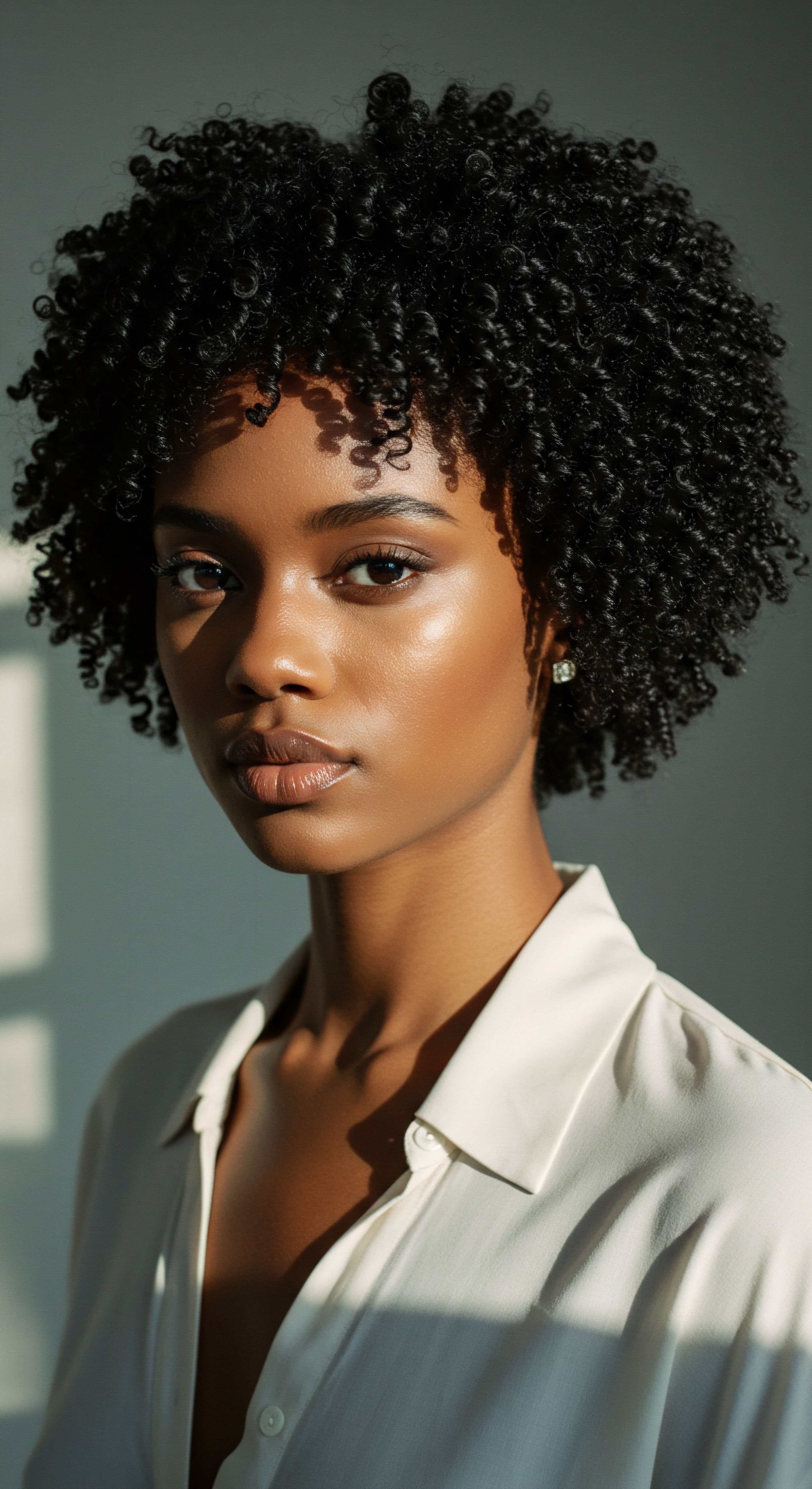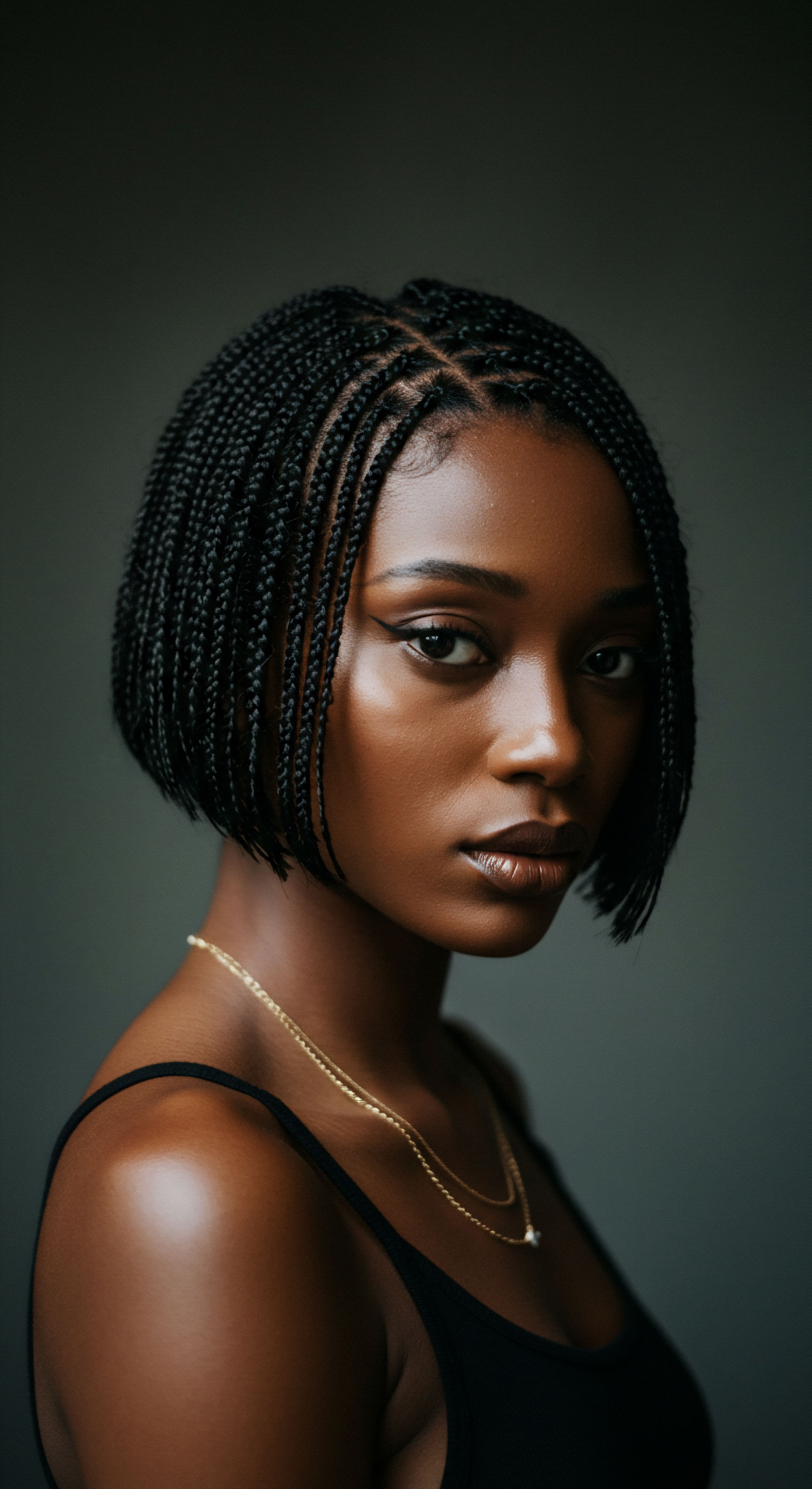
Roots
The quiet hum of the world settling into slumber often brings with it a gentle unfolding of personal rituals, moments of tender care we offer ourselves in the day’s soft twilight. For those with textured hair, this evening pause holds a particular significance, a quiet commitment to preserving the vitality of each coil, curl, and wave. A silk bonnet, far from being a mere accessory, emerges from this understanding as a foundational element of nighttime hair care, a silent guardian that respects the unique needs of these diverse strands. It speaks to a deeper appreciation for hair’s inherent structure, a wisdom passed through generations and now illuminated by modern understanding.

The Delicate Nature of Textured Hair
Textured hair, with its beautiful variations from loose waves to tight coils, possesses a distinct architecture that sets it apart. The helical shape and flattened elliptical cross-section of these strands mean they are naturally more prone to mechanical damage than straight hair. Each twist and turn along the hair shaft creates points of vulnerability, areas where the cuticle, the hair’s protective outer layer, can lift or become compromised. This inherent morphology means textured hair often experiences challenges with moisture distribution, as the natural oils from the scalp struggle to travel down the length of the coiled strands, leaving ends drier and more susceptible to environmental stressors.
Textured hair’s unique structure, characterized by its helical shape and flattened elliptical cross-section, makes it inherently more susceptible to mechanical damage and moisture imbalance.
Consider the microscopic landscape of a single strand of textured hair. Unlike the smooth, even surface of straight hair, a coiled strand exhibits numerous bends. At these bends, the cuticle scales, which ideally lie flat like shingles on a roof, can be raised.
When hair with raised cuticles rubs against rough surfaces, such as conventional cotton pillowcases, the friction can cause these scales to snag, leading to breakage, split ends, and a dull appearance. This constant, subtle abrasion during sleep, often overlooked, contributes significantly to cumulative hair damage.

The Silent Threat of Nighttime Friction
Our hours of rest, meant for restoration, can inadvertently become a period of silent assault on delicate hair. The common cotton pillowcase, a staple in many homes, is a culprit in this nightly drama. Cotton, a highly absorbent fiber, readily draws moisture away from hair, leaving it parched and brittle. Its relatively rough surface, even at higher thread counts, creates considerable friction as we shift and turn during sleep.
This mechanical stress tugs at the hair shaft, roughens the cuticle, and can lead to tangles, frizz, and ultimately, breakage. For textured hair, already predisposed to dryness and fragility, this nightly interaction with cotton can be particularly detrimental.
- Cotton’s Absorbency ❉ This natural fiber acts like a sponge, drawing vital moisture from hair and skin, leading to dryness.
- Surface Roughness ❉ The microscopic structure of cotton fibers creates friction, snagging hair cuticles and causing mechanical stress.
- Increased Tangles ❉ The friction and tugging promote tangling and knotting, making morning detangling a challenging and damaging endeavor.
The impact extends beyond mere aesthetics. When hair is consistently subjected to friction, its structural integrity weakens. The outer layer of keratin proteins can be compromised, leading to a loss of elasticity.
This means hair that once had a lively bounce might begin to feel stiff or appear lifeless. The visible signs, such as frizz and split ends, are merely the outward manifestation of this internal struggle, a call for a more protective environment during the vulnerable hours of sleep.

Ritual
As the sun dips below the horizon, and the day’s demands recede, a quiet transformation begins. The act of preparing for rest becomes a personal ritual, a moment to honor the body, and for textured hair, a time to safeguard its delicate form. Introducing a silk bonnet into this nightly cadence is not merely a practical step; it is an act of gentle preservation, a deliberate choice to provide a haven for hair that has navigated the day’s elements. It represents a shift from reactive repair to proactive protection, inviting a sense of serenity into the evening routine.

Why Does Silk Protect Hair
The remarkable qualities of silk stem from its natural protein structure, a composition akin to our own hair. Unlike plant-based fibers such as cotton, silk is incredibly smooth, possessing a low coefficient of friction. This means that when hair glides across a silk surface, there is significantly less resistance and tugging.
The hair shaft encounters minimal mechanical stress, reducing the likelihood of cuticle damage, frizz, and breakage. This inherent slipperiness allows curls and coils to retain their defined shape, preventing the flattening and distortion that often occurs with rougher materials.
Silk’s inherent smoothness and low friction properties create a protective barrier for textured hair, minimizing mechanical stress and preserving its natural moisture.
Furthermore, silk is less absorbent than cotton. Where cotton readily wicks away moisture and natural oils from hair, silk allows these vital elements to remain where they belong – on the hair itself. This moisture retention is particularly beneficial for textured hair, which tends to be drier due to its structural characteristics.
By maintaining hydration throughout the night, silk bonnets help to keep strands supple, soft, and less prone to brittleness. This gentle touch supports the hair’s natural resilience, ensuring it wakes refreshed and ready for the day.

The Nightly Sanctuary a Bonnet Creates
The application of a silk bonnet before sleep transforms the pillow into a sanctuary for textured hair. This simple action creates a controlled micro-environment, shielding strands from the abrasive forces of bedding and the drying effects of ambient air. It is a conscious decision to minimize external stressors, allowing the hair to rest undisturbed and maintain its delicate moisture balance.

How does a Silk Bonnet Minimize Friction and Breakage?
The smooth surface of a silk bonnet provides an almost frictionless glide for hair as one moves during sleep. Consider the contrast ❉ rough cotton fibers act like tiny hooks, catching and pulling at the hair cuticle, leading to a frayed appearance and eventual breakage. Silk, on the other hand, allows hair to slip effortlessly, preventing the mechanical stress that contributes to split ends and weakened strands. This gentle interaction is especially important for the delicate twist regions of textured hair, which are inherently more vulnerable to fracture.
Research highlights that mechanical force is a primary cause of hair damage, encompassing even the subtle rubbing against a pillow. Given that a significant portion of our lives is spent sleeping, providing a surface that reduces this constant friction is a meaningful step toward preserving hair integrity.
The reduced friction also means less tangling. Textured hair is often prone to tangles, which can be a painful and damaging ordeal to remove in the morning. A silk bonnet helps to keep strands aligned and contained, preventing the chaotic intertwining that leads to stubborn knots. This translates to easier detangling sessions, further minimizing breakage and preserving hair length.

Can a Silk Bonnet Truly Aid in Moisture Retention?
One of the most celebrated benefits of silk bonnets for textured hair is their capacity to support moisture retention. Cotton, by its very nature, is designed to absorb. It pulls moisture from hair, much like a towel draws water from skin. This can leave textured hair, already prone to dryness, feeling parched and brittle by morning.
Silk, being a protein fiber, is significantly less absorbent. It allows the natural oils produced by the scalp, along with any applied conditioners or leave-in treatments, to remain on the hair shaft. This sustained hydration helps to maintain the hair’s elasticity and softness, reducing the likelihood of dryness-induced breakage.
A study from the Textile Research Journal, while focusing on durability, underscores the unique properties of silk fibers compared to cotton, indirectly supporting silk’s less absorbent nature for hair. This characteristic means that products applied to hair before bed, such as oils or moisturizers, have a greater opportunity to perform their intended function, rather than being absorbed by the pillowcase. The consistent presence of moisture contributes to healthier, more resilient strands over time.
- Reduced Frizz ❉ The smooth surface of silk prevents the hair cuticle from being ruffled, leading to significantly less frizz upon waking.
- Preserved Styles ❉ By minimizing friction and tangling, silk bonnets help maintain hairstyles, from braids to twist-outs, for longer periods.
- Enhanced Hydration ❉ Silk’s low absorbency ensures that hair’s natural moisture and applied products remain on the strands, promoting softness and elasticity.

Relay
Stepping beyond the immediate tactile comfort and visible benefits, the deeper implications of incorporating a silk bonnet into a textured hair care regimen unfold into a rich narrative, one that intertwines historical resilience, scientific understanding, and a profound commitment to well-being. This is where the simple act of covering one’s hair at night transcends mere practicality, becoming a statement of care that resonates through cultural memory and contemporary self-regard. It is a quiet affirmation of the inherent beauty and strength of textured hair, understood not just through its appearance, but through its very structure and the practices that sustain it.

Cultural Echoes of Hair Protection
The practice of covering and protecting hair, particularly within Black and mixed-race communities, carries a historical weight that predates modern silk bonnets. Headwraps, scarves, and other coverings have served a dual purpose for centuries ❉ practical protection from the elements and a profound cultural marker. In various African cultures, headwraps, known by names like ‘geles’ in Nigeria or ‘dukus’ in Ghana, have signified wealth, marital status, and spiritual reverence. During periods of enslavement and oppression, these coverings became symbols of resistance and identity, a means for Black women to reclaim agency and communicate within their communities, even when laws sought to demean them.
The modern silk bonnet, while a contemporary iteration, stands as a quiet continuation of this legacy. It carries the echo of ancestral practices that understood the need to safeguard hair, whether from harsh sun, demanding labor, or the insidious friction of daily life. Choosing a silk bonnet today is, in a subtle yet potent way, an act of honoring this enduring heritage of hair protection and self-preservation. It acknowledges a continuum of care that spans generations, connecting the individual to a broader cultural narrative of resilience and pride.

The Microscopic Truth of Hair Integrity
To truly appreciate the silk bonnet’s impact, one must peer into the microscopic world of the hair shaft. Textured hair, due to its unique morphology, exhibits a higher propensity for mechanical damage. A study published in Cosmetics & Toiletries highlights that hair’s break stress decreases with an increase in curliness, as defined by the eight-point Loussouarn scale.
This data suggests that the curls and twists present in textured hair create concentrations of stress and local points of weakness when the hair is stretched, leading to fracture formation. This inherent structural vulnerability underscores why minimizing external mechanical forces, such as those encountered during sleep, becomes paramount.
Further research, specifically on hair resistance to mechanical wear, has indicated that African hair samples presented the lowest resistance to mechanical insult compared to other ethnic groups, showing a decrease in resistance of around 3-5%. This is attributed to its lower ability to stretch under mechanical stress, making it more susceptible to damage from frictional forces. This finding is not to suggest fragility as a flaw, but rather to illuminate the specific care requirements for maintaining the vitality of these hair types. The silk bonnet directly addresses this mechanical vulnerability by providing a surface that virtually eliminates friction, allowing hair to glide freely rather than snagging and tearing.
The cuticle, the outermost layer of the hair shaft, is the first line of defense against damage. When this layer is disrupted by friction, moisture loss accelerates, and the hair becomes brittle. A silk bonnet helps to keep these cuticle scales lying flat and smooth, thereby preserving the hair’s natural barrier. This action directly counteracts the effects of abrasive materials like cotton, which can lift and chip away at the cuticle, leading to increased porosity and a dull, rough feel.
| Factor Friction Levels |
| Cotton Pillowcase High, causes snagging and tugging |
| Silk Bonnet Very low, allows hair to glide smoothly |
| Factor Moisture Absorption |
| Cotton Pillowcase High, wicks away natural oils and hydration |
| Silk Bonnet Low, helps retain hair's moisture |
| Factor Cuticle Integrity |
| Cotton Pillowcase Disrupts cuticle scales, leading to lifting and damage |
| Silk Bonnet Preserves cuticle smoothness, reducing damage |
| Factor Tangle Formation |
| Cotton Pillowcase Increases tangles and knots due to friction |
| Silk Bonnet Minimizes tangles, preserving style definition |
| Factor Hair Breakage Risk |
| Cotton Pillowcase Higher, due to mechanical stress and dryness |
| Silk Bonnet Significantly lower, promotes hair strength |
| Factor A silk bonnet provides a superior nighttime environment for textured hair compared to traditional cotton pillowcases. |

Beyond Breakage Supporting Hair Health Systems
The benefits of a silk bonnet extend beyond simply preventing physical damage; they play a role in supporting the hair’s overall health system. When hair is protected from nightly friction and moisture loss, it experiences less stress. This reduced stress can contribute to a healthier scalp environment, as the hair follicles are not constantly subjected to tugging and pulling. A calm scalp is a foundation for robust hair growth.

Does a Silk Bonnet Influence Scalp Health and Hair Growth?
While a silk bonnet does not directly stimulate hair growth, its indirect contributions to scalp health are significant. By minimizing friction, it reduces the likelihood of scalp irritation and inflammation that can sometimes arise from constant rubbing against rough surfaces. A healthy scalp is essential for optimal hair growth, as it provides the necessary environment for follicles to thrive.
When the scalp is calm and free from undue stress, it can better support the hair growth cycle. Furthermore, the reduced need for aggressive detangling in the morning means less tension on the scalp and hair roots, which can also contribute to preventing traction-related issues.
Consider the impact on hair’s protein balance. Hair is primarily composed of keratin, a protein that gives it structure and strength. Excessive friction can lead to the degradation of these structural proteins and surface damage. By preserving the cuticle and reducing mechanical wear, a silk bonnet helps to maintain the integrity of these essential proteins, ensuring that hair remains strong and resilient.
This proactive preservation minimizes the need for extensive restorative treatments, allowing the hair’s natural repair mechanisms to function more effectively. The subtle shift from a damaging sleep environment to a protective one can lead to a visible difference in hair’s long-term health and vitality.

Reflection
The journey through the world of the silk bonnet, from its foundational benefits to its cultural echoes and scientific underpinnings, reveals a truth far richer than a simple beauty hack. It is a testament to the quiet power of thoughtful care, a daily affirmation of value for the unique qualities of textured hair. This unassuming accessory, born from a blend of ancient wisdom and modern understanding, stands as a gentle guardian in the stillness of night, protecting not just strands, but the spirit of self-regard. It is a reminder that sometimes, the most profound acts of care are found in the simplest, most consistent rituals, allowing hair to truly flourish, not just survive.

References
- 1. Afope-Oyinlola, T. (2020). Signs of Protein Sensitive Hair & Why Your Hair Reacts This Way to Protein. YouTube.
- 2. Byrdie. (2025). Satin vs. Silk Pillowcases for Hair ❉ What’s the Difference?
- 3. Cosmetics & Toiletries. (2020). Defying Damage ❉ Understanding Breakage in Afro-textured Hair.
- 4. Dtex Homes. (2025). Which Pillowcase Is Better for Your Hair?
- 5. Esteworld. (2025). Does Sleeping on Only One Side Cause Hair Loss?
- 6. Good Health by Hims. (2025). Protein Overload in Hair ❉ Symptoms, Causes, and Treatment.
- 7. Hairlust. (2024). Bamboo vs. Silk Pillowcase ❉ 4 Reasons You Should Pick Bamboo.
- 8. HFHG Clinics. (2024). Proven Ways on Prevent Hair Damage and Breakage.
- 9. JD Institute of Fashion Technology. (2021). Headwraps ❉ History and Evolution.
- 10. Jelani Travel. (2024). The History and Symbolism of Hair Wrapping Across the African Diaspora.
- 11. Lab Muffin Beauty Science. (2020). Silk for Skincare and Haircare.
- 12. Lordhair.com. (2024). Silk vs Cotton Pillowcases ❉ Which Is Best for Your Hair?
- 13. MDPI. (2023). Porosity and Resistance of Textured Hair ❉ Assessing Chemical and Physical Damage Under Consumer-Relevant Conditions.
- 14. Mulberry Park Silks. (2024). Choosing the Best Pillowcase for Thin or Fine Hair.
- 15. Obé Headwear. (2024). Significance of headwraps.
- 16. Pattern Beauty. (2024). Is Your Natural Texture Experiencing Protein Overload?
- 17. Re’equil. (2020). Which is the best protein treatment for hair?
- 18. Silkie. (2024). The Link Between Sleep Position and Hair Damage ❉ What You Need to Know.
- 19. Sonson. (2021). The History of Headwraps and Black Culture.
- 20. The Chic Icon. (2024). Secret Benefits of Silk for Hair and Skin.
- 21. The Hair Loss Institute. (2025). Can The Way You Sleep Cause Hair Loss?
- 22. Trichology. (2023). Prevent Hair Breakage with our Anti-Damage Solution!
- 23. Trichology. (2024). Trichology Insights on Nutritional Wellness to Prevent Hair Loss.
- 24. Wilderness Safaris. (2015). The history & meaning of head wraps across Africa.